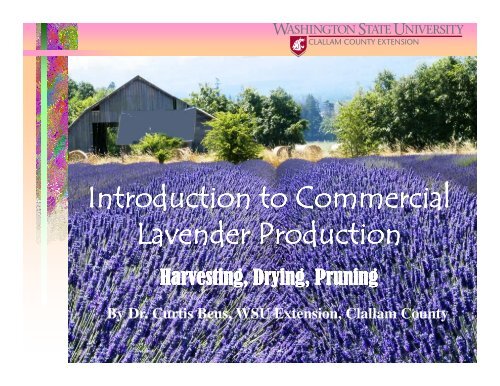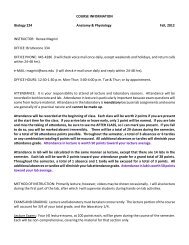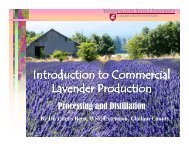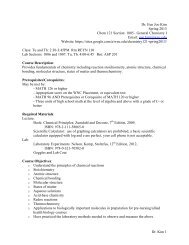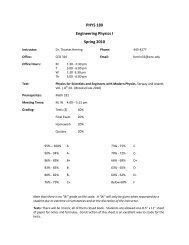Lavender Harvesting
Lavender Harvesting
Lavender Harvesting
You also want an ePaper? Increase the reach of your titles
YUMPU automatically turns print PDFs into web optimized ePapers that Google loves.
Introduction to Commercial<br />
<strong>Lavender</strong> Production<br />
<strong>Harvesting</strong>, Drying, Pruning<br />
By Dr. Curtis Beus, WSU Extension, Clallam County
<strong>Harvesting</strong> <strong>Lavender</strong>
<strong>Harvesting</strong> <strong>Lavender</strong><br />
Never harvest lavender when wet<br />
• If harvesting lavender for producing dried<br />
bundles, harvest stems when the first few<br />
flowers have bloomed.<br />
• If harvesting lavender for producing dried<br />
lavender flower buds, harvest when about<br />
half of the buds are in bloom<br />
• If harvesting lavender for fresh bundles,<br />
harvest when about 20% to 50% of buds<br />
are in bloom<br />
• If harvesting lavender for oil production,<br />
harvest at full bloom, or when up to half of<br />
the blooms have withered<br />
• Small scale growers typically harvest by<br />
hand with a curved sickle/knife, and tie<br />
bundles together with a rubber band<br />
• Larger growers who grow for oil<br />
production use various mechanical<br />
harvesters
A group of<br />
inexperienced<br />
lavender harvesters<br />
– not doing the best<br />
of jobs!
<strong>Harvesting</strong> <strong>Lavender</strong> Efficiently and for Quality<br />
Firmly grasp a<br />
bunch of stems at<br />
their base
<strong>Harvesting</strong> <strong>Lavender</strong> Efficiently and for Quality<br />
Use sickle knife and<br />
quickly pull it at<br />
base to cut off<br />
bunch – may need<br />
to make 2-3 cuts to<br />
complete a bundle
<strong>Harvesting</strong> <strong>Lavender</strong> Efficiently and for Quality<br />
Use rubber bands<br />
around the wrist to<br />
tie off bundle
<strong>Harvesting</strong> <strong>Lavender</strong> Efficiently and for Quality<br />
Pile cut bundles<br />
on top of<br />
harvested plants
And experienced<br />
harvester can<br />
harvest one plant in<br />
about 3-5 minutes –<br />
about 4-7 bundles<br />
per plant depending<br />
upon size of plant
Drying <strong>Lavender</strong><br />
Paper clip<br />
Rubber band<br />
• Effective drying is absolutely<br />
critical to producing quality<br />
lavender products!<br />
• <strong>Lavender</strong> needs to be dried in<br />
a dark, dust- free place with<br />
good ventilation to allow for<br />
quick and complete drying.<br />
• Too humid conditions and/or<br />
poor air movement will result in<br />
moldy lavender<br />
• Light—especially sunlight—<br />
will cause lavender to fade and<br />
turn gray
Pruning <strong>Lavender</strong><br />
This is what happens if<br />
lavender is not pruned!<br />
• After harvest, plants need to be pruned and shaped. This<br />
should be done before the first hard frost<br />
• Cut plants back to leave 1-2 inches of green beyond woody<br />
stems (try to leave 2-3 nodes of the current season’s wood)<br />
• <strong>Lavender</strong> needs to be pruned back hard, or plants will<br />
become too large, woody and will splay open in the middle
This is NOT the way<br />
to efficiently prune<br />
lavender!
A typical plant after harvest<br />
OK, I harvested this one way early for the purpose of demonstration
Using a gas hedge trimmer to prune<br />
Takes about 1-2 minutes per plant
A properly pruned plant
A properly pruned plant<br />
Leaving about 1” of green growth above old wood
Properly pruned lavender will withstand winters<br />
better, will last longer, be healthier and produce<br />
more quality product<br />
Note the fans for air movement


